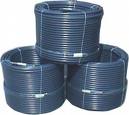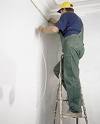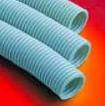Requirements for laying protective pipes for electrical wiring
Methods of laying protective pipes with electrical wiring
In industrial premises, electrical wiring in protective pipes can be laid along walls and ceilings (open and hidden), along metal structures of buildings, technological equipment, in the floor (grooves) when approaching equipment, etc. For external installations — along the structures of buildings and structures, on technological and cable racks.
In this case, the recommendations in the field of application of different types of protective pipes should be taken into account, depending on the characteristics of the premises, the environment and the characteristics of the building structures. It is not allowed to lay electric wires in protective pipes of any kind in the ground (excavations), except for laying in grout on the floor indoors.
Selection of the route of electrical wiring in protective pipes
 When choosing the route of electrical wiring in protective pipes, it is necessary to avoid crossings and coincidences of the laying direction with chimneys, pigs and other hot ones. surfaces. When crossing hot pipelines and laying parallel to them, measures must be taken to protect electrical wiring from the influence of high temperature (thermal insulation of hot pipelines, installation of heat-insulating screens, distribution of electrical wiring from hot pipelines to distances where the influence of temperature does not affect, etc.).
When choosing the route of electrical wiring in protective pipes, it is necessary to avoid crossings and coincidences of the laying direction with chimneys, pigs and other hot ones. surfaces. When crossing hot pipelines and laying parallel to them, measures must be taken to protect electrical wiring from the influence of high temperature (thermal insulation of hot pipelines, installation of heat-insulating screens, distribution of electrical wiring from hot pipelines to distances where the influence of temperature does not affect, etc.).
The distances from the protective pipes of electrical wiring to other pipelines must ensure normal conditions for installation and operation of electrical wiring and be: when crossing technological and other pipelines — at least 50 mm, and pipelines with flammable and combustible liquids and gases — at least 100 mm; for parallel laying with technological and other pipelines — not less than 100 mm, and with pipelines with flammable and combustible liquids and gases — not less than 400 mm.
Marking of the route for laying protective pipes with electrical wiring
Marking of routes on straight sections when laying electrical wires on the walls is carried out in such a way that all boxes on the site are on the same line, parallel to the architectural lines (cornices, windows or doors, pillars, pilasters, columns, boards and others.).
Requirements for placement of protective pipes
 The protective pipes must be laid in such a way that moisture from vapor condensation does not accumulate in them; bypassing obstacles in horizontal sections of pipe laying must not create an opportunity for moisture to accumulate.
The protective pipes must be laid in such a way that moisture from vapor condensation does not accumulate in them; bypassing obstacles in horizontal sections of pipe laying must not create an opportunity for moisture to accumulate.
The height of laying electrical wires in protective pipes from the floor, ground or service platform is not standardized.
Methods of protection of non-metallic protective pipes
When using non-metallic protective pipes in places where they can be damaged, additional mechanical protection should be provided with pieces of metal pipes, angle steel, etc. thin-walled steel tubes are used externally; pipe joints are sealed. Non-metallic pipes when exiting foundations and floors of fire-resistant walls are protected up to a height of 1.5 m.
Laying protective pipes for electrical wiring in the floors of rooms
The laying of metallic and non-metallic pipes in the floors of premises is carried out in the thickness of the floor grout at a depth that ensures the monolith of the pipes with a concrete solution with a layer of at least 20 mm above the pipe.
Compensating devices must be provided at the intersections of electrical wiring in protective pipes with expansion and sealing seams.
Methods of securing and connecting protective pipes
 Fastening of exposed steel pipes can be done with brackets, clamps and g.p. The distance between the points of attachment of exposed steel pipes should not be more than: pipes with a nominal opening of 15 — 20 mm.
Fastening of exposed steel pipes can be done with brackets, clamps and g.p. The distance between the points of attachment of exposed steel pipes should not be more than: pipes with a nominal opening of 15 — 20 mm.
The connection of non-metallic pipes is carried out using connectors and sockets: vinyl plastic with subsequent gluing; polyethylene with subsequent welding in connectors or hot casing in sockets. Bending of plastic pipes is done with preheating.
In the installation of protective pipes for electrical wiring, pass-through and junction boxes are used, which serve to create normal conditions for pulling wires into pipes and for branching part of the wires from a common route.
The connection of non-metallic pipes is carried out using connectors and sockets: vinyl plastic with subsequent gluing; polyethylene with subsequent welding in connectors or hot casing in sockets. Bending of plastic pipes is done with preheating. In the installation of protective pipes for electrical wiring, pass-through and junction boxes are used, which serve to create normal conditions for pulling wires into pipes and for branching part of the wires from a common route.
